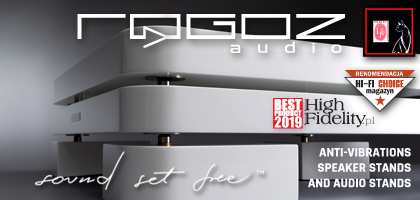No. 260 January 2026
- COVER REVIEW: EVERSOLO DAC-Z10 ⸜ digital-to-analog converter/preamplifier » CHINA
- AWARDS: BEST OF 2025 according to the HIGH FIDELITY » WORLDWIDE
- KRAKOW SONIC SOCIETY № 154: CRYSTAL DISC • AudioNautes Recordings » ITALY - JAPAN - POLAND
- REVIEW: FEZZ AUDIO Luna Mini Evo ⸜ integrated amplifier » POLAND
- REVIEW: GARLUBIDOR Divinity ⸜ digital-to-analog converter » CHINA
- REVIEW: XAVIAN Natura Unica ⸜ loudspeakers • stand-mounted » CZECH
- MICRO-REVIEW: ACOUSTIC REVIVE QSB-3810 ⸜ spike pads » JAPAN

|
Editorial
Text by WOJCIECH PACUŁA |
 |
No 260 January 1, 2026 |
|
„I WANT MY HDCD!” IT'S COOL TO LEARN NEW THINGS that are also things that somehow break away from the mainstream. Cool, but also difficult. This requires much more effort and energy than staying in familiar, safe places that are always the same. Areas reserved for art and technology – because I wanted to mention them too – that are unconventional are therefore dangerous, although they evoke not so much fear as internal resistance. 
⸜ Korean “healing” novels are considered a continuation of globally popular content such as K-pop and K-dramas. Above is the cover of the novel Marigold Mind Laundry in various countries. • photo: official Instagram Book Romance account; source: → www.KOREA.net Generally speaking, we run away from pain, which is probably the first instinct of every living creature, whether we are talking about animals, insects, plants, or other forms of life. And encountering the unpredictable is comparable to physical pain. Touching something “new” therefore causes, not always, but generally speaking, anxiety and a reflexive withdrawal of the hand. This is where the incredible popularity of literature, film, and music that “envelops” us comes from. I have al-ready written about this: so-called “blanket stories”, or “healing novels”—heartwarming novels whose charac-ters find meaning in mundane activities—are currently being excelled at by South Korean creators and are breaking popularity records. And it's not even about contemporary fiction, but rather crime novels. The Lubimy Czytać portal says:
The same goes for music. So we reach for albums that we associate with good memories, usually related to our youth, idealized and filtered through memories that reject what hurts us. We reach for albums that we know well and know what to expect. It's normal, it's good, it's cool. That's how we are. That's why during the holi-day season, or in the capitalist world, after November 1st, we listen to songs with bells. Like me right now, looking out the window at the first snow of the year. 
⸜ Examples of cosy crime novels according to Publio • photo press release → PUBLIO.pl, accessed: 21.11.2025. It is this same need for security that gives rise to the strong trend of retro mania, which Simon Reyn-olds wrote about in his book Retromania: How Pop Culture Feeds on Its Own Past. Reynolds analyzes contemporary pop culture and its fascination with the past, pointing out an excessive dependence on returning to existing trends and musical genres. For him, this is clearly a bad attitude and a harmful trend. He says that obsessive repetition of history harms the creativity and originality of contemporary art, examining phenomena such as the revival of vinyl and sampling. Was he 100% right when he wrote this in 2011? After all, vinyl and sampled music are worlds unto themselves. If I say no, will I be a reactionary, a rotten bourgeois, and a terrible conservative? Maybe so, but f*** it, I'll say it anyway. If that's what it takes to be someone who calls for common sense today, then so be it, I'm all of those things. Let this be an act of courage on my part :). By the way, who would have thought that it would be an act of courage not to break stereotypes and strive for a “better future”, which is always somewhere else and not now, but to take the side of moderation. But to the point: in my opinion, the calming role of “enveloping” art is just as important as its exploratory and innovative role. It is not a question of which is more important, but of a healthy balance. We need both, as I'm sure you will agree. That's why, when I reached for a CD last night, my hand unconsciously moved towards a shelf I hadn't visited in a long time, where John Foxx and Belbury Circle's CD entitled Empty Ave-nues sat quietly. 
⸜ JOHN FOXX, BELBURY CIRCLE, Empty Avenues, Ghost Box GBX019CD ⸜ 2013 Ah, what great music it it! Released in 2013, it brought together Foxx's processed vocals and elements of mod-ern electronica, seasoned with old-school electronic backing tracks. It is a calm, almost meditative al-bum. And yet Foxx, actually Dennis Leigh, an English singer, musician, and artist who was the first vocalist of Ultravox, is considered one of the pioneers of electronic and synthesizer music. In other words, someone who broke conventions, went against the grain of the then-ubiquitous rock music, including progressive rock, as well as the rising wave of punk. He was one of the revolutionaries. After an initial period of “cold” playing, he gradually began to smooth out his sound, which resulted in the excel-lent 1981 album The Garden, which fit in with the mood of new romantic music. Reaching as far into ambient as he did with Empty Avenues seems like a natural conclusion for him. And not just for him. When we listen to the contemporary achievements of people who created electronic music in the 1970s and early 1980s, we see that their careers followed a similar trajectory: from experimentation to calmness. That's why, after Foxx, I automatically chose to listen to the 2010 album Here is why by Pieter Nooten, co-founder and co-creator of the first two Clan of Xymox albums recorded for 4AD, remembering that I have it autographed... It's the same direction, the same nostalgia and long sounds. The album was recorded and mixed entirely at the artist's home using a Mac Book Pro. In other words, in the “comfort of his own home”, one might say, in his safe “belly”. And again, it was great to listen to. All the more so because it was accompa-nied by reading material that matched the mood. 
⸜ Examples of ambient, calm, cool albums by artists known for much bolder releases: FOXX & BELBURY, PIETER NOOTEN (up), KARL BARTOS (at the side) LISA GERRARD (down) Having just finished reading the first volume of Karl Ove Knausgård's Morning Star series, author of the phenomenal My Struggle, perhaps sensing snow in the air, I pulled Andrzej Stasiuk's long-unread collec-tion of short stories, Kucając, from the shelf. Beautifully published in 2015 by Czarne, with illustrations by Kamil Targosz, it contains short, often one-page impressions on nature. Most often cruel in nature, at least from our point of view. In what way they are a complete change from what the author of The Walls of Hebron wrote in Dukla, a novel classified as part of the “small home-lands” genre, published at a time when I was studying this type of literature at university? This is a genre of writ-ing that focuses on autobiographical memories and reflections on the local landscape, often from the perspective of a lost childhood or traditional culture. These works show the world as the center of reality (axis mundi), into which history and civilization brutally intrude, destroying the old order. And now – I needed all of that. That's why I understand those who listen to music just to relax, read literature to relax, watch movies to “switch off” (one of my friends called it “brainwashing”). I do the same. I also under-stand the choices of audio professionals who have recently been shaping the sound of their devices in such a way that they can be described as warm and aimed at delivering a cool, “enveloping” presentation. If you look at last year's tests in “High Fidelity”, you will see that there are really many of them. And importantly, this is intentional choice, not accidental. But... As they say, “but” erases everything that came before – it's not the whole truth, but part of it. The fact is that exposure to something we are not used to, something that challenges us, is important for our development, even essential. It requires everything I have written about, which can be summed up as “courage”, but there is no other way. That is why I listened with such attention and curiosity to one of ECM's latest albums, Meredith Monk's Cellular Songs (ECM New Series). 
⸜ Difficult, but one of the kind – Meredith Monk i Cellular Songs • photo press release ECM It is difficult music, but once it has been “instilled” in us, it stays with us. For the same reason, it is worth listening to Hania Rani's album Non Fiction, even if, as reviewer Jarosław Kowal suggests, it may come as a sur-prise, initially incompatible with the familiar, orderly, and safe image of this artist. In her performance, it would be the equivalent, but with the opposite twist, of what I wrote earlier when referring to John Foxx and Peter Nooten. To whom we could add Roland Barthos and other musicians from Kraftwerk or Tangerine Dream, to mention other pioneers, people who were once courageous and are now deliberately derivative. Defining the trend that Rani has been following so far, the journalist writes:
|
As he adds at the end, despite his hesitations, he finally became convinced by this new, orchestral, largely im-provised version of her work. As I said, in addition to our “security blanket”, we also need challenges, otherwise we slip into a pleasant, friendly, but also rather barren in terms of results sphere of what “suits” us. Or rather, it is not what suits us, but what we adapt to. This is particularly evident in audio. When we think about what I wrote about warming up the sound, we will also remember that nothing particularly innovative has happened in audio for years, and we will agree with Reynolds that most people's preference for vinyl, or even cassette tapes, has little to do with sound quality, but rather with fashion and cultural re-cycling. 
⸜ One of the „forgotten” audio technologies that I’d like to see one day again: HDCD; in the photo, a handful of the first CDs encoded in this way that I took off the shelf without even looking for them After all, all “modern” technologies, such as streaming, have their roots in the 1940s and are already quite old. Even if we look at how new audio devices look, we will have to face the truth that shines through: everything has already been done. And there is nothing really new and innovative on the horizon. There is not even a chance for that. Large companies only finance what will bring short-term profits, ignoring basic research. However, as I wrote, not everything “that has already been” is bad, even though the market would like to grind it down and move on to something else. It is not about reaching for proven solutions or emotions and immersing ourselves in them, but about using them to help us without obscuring what lies ahead. So there are things that I would like to see in a new version. I feel that some of them disappeared from the market too quickly and deserve to be remembered. For example, the HDCD (High Definition Compatible Digital). Rotel, a Japanese audio manufacturer that was once a strong supporter of this format, still publishes a defi-nition of this solution on its website:
This encoding and decoding format, owned by Microsoft since 2000, was developed between 1986 and 1991 by “Prof.” Keith O. Johnson (now Reference Recordings and Spectral) and Michael “Pflash” Pflaumer for Pacific Microsonics. The idea was to record a signal with a word length of 20 bits (44.1 kHz) on a disc that looked like a CD and was backward compatible with CD players. 
An analog-to-digital converter encoding the signal was specially designed for this purpose. On the player side, a suitable chip was required – first the PMD100, and then the PMD200, which decoded the HDCD signal and of-fered sophisticated digital filters. The latter feature was also highly valued when using classic CDs. I wanted to write about it ten years ago, right after publishing an article describing the Compact Disc format, which appeared in “High Fidelity” in the “In Praise of Format” series; more → HERE. This is because it was the first attempt to transfer high-resolution signals, in this case 20-bit, to the world of Compact Disc. However, in order to do this properly, I wanted to have access to the two most important devices of this type, the Spectral SDR-4000 and the Linn Sondek CD12. Unfortunately, I was unable to borrow them and I had to put a pin in the topic. However, I have not forgotten about the format itself. Although from today's perspective, twenty bits with a sampling frequency of 44.1 kHz seems like nothing, in reality it was a big change for the better. However, as I see it today, it was not just about adding bits. The transition by Denon and Telarc from 16-bit to 20-bit recording also resulted in a leap in sound quality. In my opinion, the main advantage of the HDCD format (I write “for-mat” because it is a real format, different from Compact Disc) was the use of excellent digital filters on both the recording and playback sides. 
⸜ One of the most interesting HDCD Player, Linn Sondek CD12 • photo press release Linn I am sure you have encountered switchable filters in D/A converters. This is a popular method of enhancing sound quality, as ESS Technology, the manufacturer of most of the chips of this type used in modern digital audio devices, offers such option. If so, you know that they can vary quite significantly. I always choose those with a long decay time and low phase distortion or apodization; aliasing and bandwidth issues are secondary to me. Digital filters in Pacific Microsonic converters and HDCD decoding circuits worked in a similar way on the player side. On the website of Spectral, a company for which one of the co-creators of the HDCD stand-ard, Mr. Keith Johnson, designs, we read:
That's true. And all of this, in my opinion, boils down to proper timing and phase shifts. That's why I think HDCD is one of the most interesting ways to enhance CD sound, which has been abandoned. The second would be MQA-CD, were it not for the fact that it is still offered by the giant Warner Music Group, as well as small publishers such as Chesky Records, 2L, and AQCD Technology Company Limited. 
⸜ The first MQA-CD offered by AudioNautes Recordings: Dave Brubeck Quartet i Time Out And AudioNautes Recordings. The latter presented its first title encoded in this way, Time Out by the Dave Brubeck Quartet, on a gold UHQCD disc with an MQA layer, and it will soon be available on Crystal Disc. As Fabio Camorani, head of AudioNautes, said, he conducted many tests to determine which format and medium were best, and he concluded that the medium was Crystal Disc, followed by Ultimate HQCD on a gold base, and the format was MQA-CD (HQCD – High-Quality CD). We are talking about MQA encoding that has been developed by Meridian Audio since 2015, when it was pre-sented at the Consumer Electronics Show (CES); MQA – Master Quality Authenticated. It has its supporters and opponents, just like HDCD once did. It was conceived as a format that would allow high-resolution files to be transmitted over the Internet. However, its most important feature was digital filters that ensured the lowest possible – yes, yes – phase shifts and time blurring. That is why my dream is to have a Super Audio CD player equipped with both decoders – MQA and HDCD. The latter, in its later form PMD-200, was an algorithm stored in a DSP chip, similar to today's MQA, so this should not be a problem. This could be Microsoft, which is the current owner of the HDCD format. It ac-quired it in 2000 with the purchase of Pacific Microsonics' assets, incorporated it into Windows Media Player, and then abandoned it. But maybe something can be done about it? If so, I wouldn't count on manufacturers from Europe, Japan, or the US, but rather on the madmen from China, India, Singapore, etc. That's where the heart of high-end beats right now, that's where the most interesting products are created. They are reaching for solutions that have been abandoned in the West, such as discrete D/A converters or I2S connections on HDMI cables, which carry DSD signals, so why not something like that? Which is what I would wish for myself and for you, to para-phrase Sting's song “I want my MTV!” He got it, so why shouldn't I? 
I wish the same for you. As well as peace, goodness, safety, love, warmth, and positive emotions. We can get all of this from our loved ones and from music – it is its incredible, almost magical property. May Christmas be a time for all of you, dear readers of High Fidelity, when you can devote yourselves in peace of mind to the pas-sion that the world calls “audiophilia”, and which we consider an important part of life, just like that. May it be so in 2026 as well. WOJCIECH PACUŁA |
About Us |
We cooperate |
Patrons |
|
Our reviewers regularly contribute to “Enjoy the Music.com”, “Positive-Feedback.com”, “HiFiStatement.net” and “Hi-Fi Choice & Home Cinema. Edycja Polska” . "High Fidelity" is a monthly magazine dedicated to high quality sound. It has been published since May 1st, 2004. Up until October 2008, the magazine was called "High Fidelity OnLine", but since November 2008 it has been registered under the new title. "High Fidelity" is an online magazine, i.e. it is only published on the web. For the last few years it has been published both in Polish and in English. Thanks to our English section, the magazine has now a worldwide reach - statistics show that we have readers from almost every country in the world. Once a year, we prepare a printed edition of one of reviews published online. This unique, limited collector's edition is given to the visitors of the Audio Show in Warsaw, Poland, held in November of each year. For years, "High Fidelity" has been cooperating with other audio magazines, including “Enjoy the Music.com” and “Positive-Feedback.com” in the U.S. and “HiFiStatement.net” in Germany. Our reviews have also been published by “6moons.com”. You can contact any of our contributors by clicking his email address on our CONTACT page. |
 



|
   |
main page | archive | contact | kts
© 2009 HighFidelity, design by PikselStudio,
projektowanie stron www: Indecity











